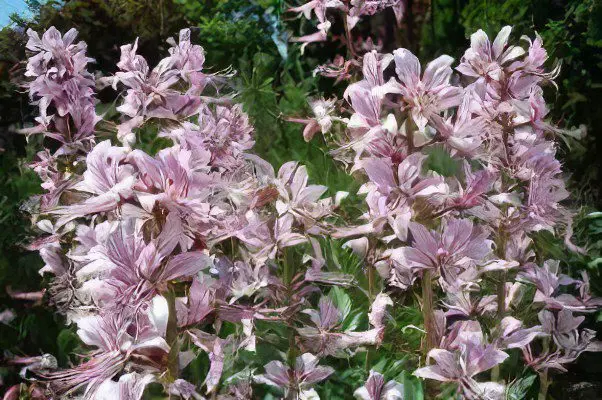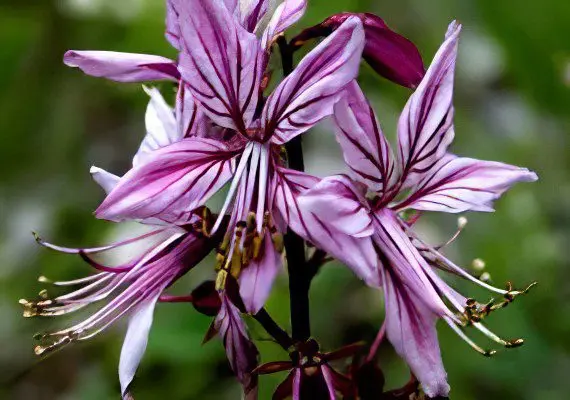Contents
Useful properties and use of white ash
Botanical characteristics of ash

Yasenets – This is a tall, perennial, herbaceous plant, in the flowers of which are essential oils. It belongs to the rue family. The root system of the ash tree is rich in branching. The stem of the ash tree is slender, slightly shaggy, reaches a height of 90 cm. In its upper parts, you can find many black dots, which are glands.
The leaves of the ash tree are usually pinnate, with 5–7 small pairs of leaflets. The leaves also contain many glands, which look like many holes. The inflorescences of the ash tree are racemose and have a rich color range: from pinkish-white to lilac-violet tones. The flowers have up to 5 petals with dark purple veins. The shape of the petals is characterized by a rounded elongation, which tapers to one or two non-pointed corners. The fruits of the ash tree take the form of a box.
Ash tree blooms in June-July, but the fruits of the plant ripen in August. Ash tree gives off a very strong citrus scent when flowering. This is due to the presence of a huge amount of essential oils in flowers. This grass grows mainly in Siberia, in the countries of Eastern Europe, in China, in India, in Mongolia and the countries of Central Asia. Rarely it can be found in the Ural mountains.
Useful properties of ash
The roots and stems of the ash tree contain many useful substances, thanks to which many diseases can be treated. The flowers, leaves and stems are high in essential oils. Ash is known to be rich in alkaloids (skimyanin, dictamnin, choline), dictamnolactone, saponins, bergapten, anthocyanins and flavonol glycosides. The root contains fatty acids and sitosterols.
To prepare medicinal raw materials for the purpose of harvesting it, it is important to properly collect, dry and ensure proper storage. The roots are dug up in spring or late autumn and dried; other parts of the plant are also dried. These actions are carried out at a temperature not exceeding 30 °C. Some homeopathic remedies made from ash wood require fresh leaves and flowers.
When collecting ash, it is recommended to wear gloves and avoid getting grass on bare skin, as this plant can cause burns. It is known that when a match is brought to a blossoming ash tree flower, a small blue flame flares up, explained by the presence of volatile essential oils. It is not recommended to smell ash flowers for the same reason – there is a high risk of severe burns. Ash is considered a poisonous plant.
Bergapten, found in the plant, is considered a substance that causes sensitivity to light, so you should be careful when preparing infusions from ash.
The use of ash
Due to its rich chemical composition, the ash tree is widely used in folk medicine. Many effective decoctions and infusions can be prepared from it, which will be useful for all human organ systems. For the genitourinary system, the plant serves as an indispensable tool and acts as an effective diuretic, regulating the menstrual cycle of women, its infusions help with chronic forms of cystitis and kidney stones.
Ash tree perfectly eliminates the problems of bloating and perfectly utilizes worms. For the digestive tract, herbal infusions serve as a medicine in the treatment of flatulence and gastritis. Such a universal medicinal plant as ash, prepared in special proportions, serves as a good remedy for epilepsy and asthenia, overwork and insomnia. It is also used as a body tonic. Aqueous extracts of ash tree are used for sciatica.
The preparation prepared from the roots of the ash tree copes with dermatitis and eczema. Ash is known to treat sexually transmitted diseases such as trichomonas vaginitis.
Recipes for infusions and decoctions
Recipe number 1. It is used to treat women’s diseases by infusion of ash roots. This recipe is intended for the treatment of fibroids, cervical erosion and mastopathy. It should be allowed to infuse 50 g of ash root in 0,5 l of vodka. Reception scheme: 3 times a day, 1 teaspoon diluted in a glass of water. The course of this treatment is repeated after a break of a month.
Recipe number 2. The remedy is used to treat impotence. Seeds in the amount of 50 pieces must be poured with vodka (0,5 l), the infusion should be kept for 2 weeks. Reception schedule: 1 tablespoon 3 times a day.
Recipe number 3. This decoction is used to treat cystitis and jaundice.. It is required to take the bark of ash roots in combination with honeysuckle in a total of 6 g and, adding licorice, in an amount of 3 g, boil. Application: 2 times a day, 1 teaspoon.
Dittany
White ash tree (the second name of the plant is “burning bush”) is a perennial plant that has a strong characteristic smell. The stem of the white ash tree reaches 1,5 m in height, is a little fluffy, has no branches, sticky to the touch, strictly elongated upwards, straight. The leaves of this plant are pinnate, with pairs of lanceolate leaves up to 5–7 pieces, bright green in color, tending upward at an angle of 45 °.
Inflorescences have large flowers in an amount of 3 to 5 pieces. The flowers are white-pink, with red veins that adorn the flower. The flowers have long pistils with a color that harmonizes with the flower itself. A purple stamen flaunts at the end. White ash blossoms in June-July, spreading its pungent smell throughout the district, and in August its fruits fall, which resemble the smell of cinnamon.
In hot weather, essential oils are released from the ash tree, as a result of which, a certain haze can be seen above it. This is due to the self-ignition of these substances. Ash grows on the edges of the forest, on rocky rapids, is not afraid of the sun’s rays. He prefers calcareous soil. In folk medicine, infusions and decoctions of white ash are used for hysteria, disorders of the gastrointestinal tract, heart disease, female and male diseases, etc. The plant is not used in official medical medicine.
Caucasian ash

Caucasian ash tree, or Dictamnus caucasicus, is considered a rare perennial herbaceous plant. For growth, this species chooses rocky terrain; conditions of rocky terrain are also considered favorable. The height of the stem of the Caucasian ash tree is from 30 to 80 cm. The stem of the plant is shaggy, pubescent with curly hairs. The leaves, like all types of ash, are pinnate, have a special ovoid-pointed shape, large, with many holes through which essential oils are passed. As a rule, the leaves of the plant are green.
The flowers of the Caucasian ash tree are large, lilac-white, sometimes violet-pink with characteristic streaks of purple. The flower has up to 5 sepals, also covered with glands. All petals are different sizes. This species blooms in May-June. The plant has a toxic effect on living organisms.
Due to the high content of alkaloids and volatile essential oils, Caucasian ash has a local irritating property. After contact with this plant, dermatitis begins within a day, and in some cases allergic shocks occur. It is undesirable to touch the Caucasian ash tree. It is also dangerous to smell this beautiful plant.
Ash-tree golostylisty
Holostolbikovy ash tree, or Dictamnus gymnostylis Stev., is a fairly tall herbaceous plant (up to 70 cm), which is characterized by the presence of beautiful pink flowers of large sizes. Almost all parts of the plant (stems, petioles and fruits) are strongly pubescent, they have glandular hairs through which essential oil is released, the smell of which is very unpleasant. Moreover, this oil has a blistering effect.
Any contact with the plant can cause skin burns, resulting in the formation of severe blisters. Poisonous essential oil has its purpose – to protect the plant from direct sunlight. Ash-tree golostyolbikovy is cultivated as an ornamental plant. This type of ash has a healing effect and is used in folk medicine.
The ash tree grows in the Crimea, in the Dnieper region of Ukraine, in the Volga-Don region of Russia and in the Republic of Moldova. All parts of the plant are used as medicinal raw materials – aboveground and roots. Alkaloids, essential oil were found in the roots, essential oil in the aerial part of the plant, furocoumarins (xanthotoxin, psoralen) in the fruits, and fatty oils in the seeds.
Decoctions and infusions prepared on the basis of this plant are recommended as an effective diuretic and anthelmintic. Ash preparations are also effective in epilepsy, depressive states, diarrhea and nephrolithiasis. Decoctions are used externally to treat rheumatism. The collection of plants must be carried out with extreme caution. Be sure to use gloves. Treatment can be carried out only under the supervision of a physician, and overdose should be avoided.
Recipes for decoctions and infusions
Recipe number 1. For the treatment of depressive states, it is necessary to take 6 grams of ready-made raw materials (crushed roots) and pour 200 ml of water into it. Next, put the container on the fire and boil for 5 minutes, then insist and strain for 1 hour. Reception schedule: 1/4 cup after meals 3 times a day.
Recipe number 2. For the treatment of diarrhea, you will need to take 5 grams of ready-made raw materials (seeds of golostyolbikovy ash tree) and pour water (200 ml), put on fire and boil for 5 minutes, then insist and strain for 1 hour. Reception schedule: 1-2 tablespoons an hour after meals, 3 times a day.









